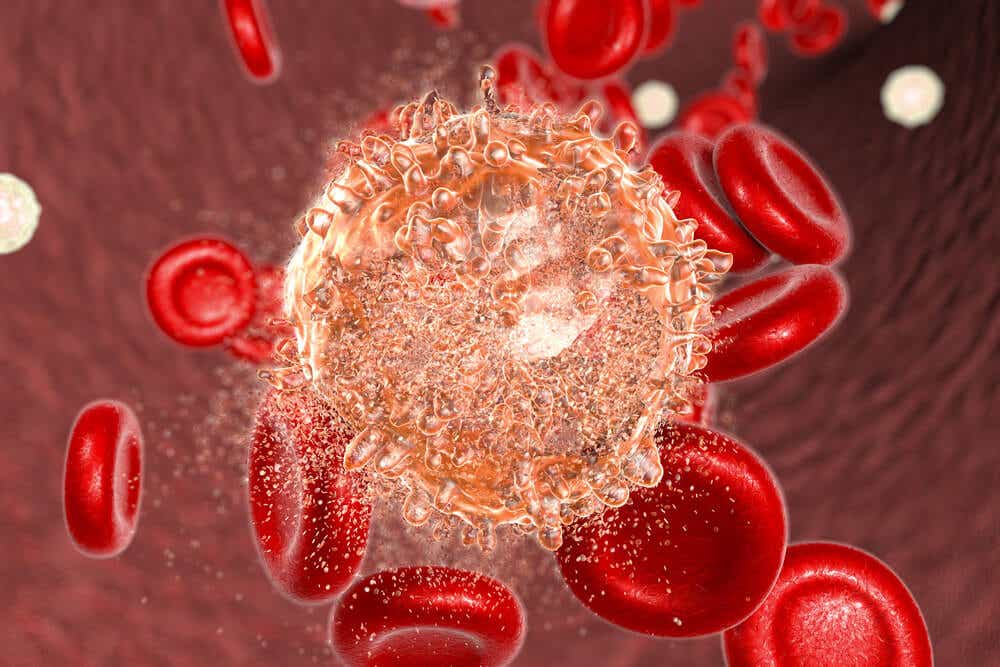I can diagnose


Definition
AML is a heterogeneous blood disorder in terms of cytogenetic, molecular, epigenetic, phenotypic and morphological characteristics.[1] The diagnosis is established by the presence of 20% or more blasts of myeloid origin in the bone marrow or peripheral blood.[1] AML can be classified according the classification system established by the World Health Organization as revised in 2016.[2]
Clinical Presentation
AML is characterized by the inhibition of differentiation and the subsequent accumulation of cells at various stages of incomplete maturation, and by the reduced production of mature hematopoietic cells. Cytopenia’s cause clinical manifestations, with symptoms and signs of anemia (such as fatigue and dyspnea), neutropenia (such as infections), and thrombocytopenia (such as hemorrhage), which are usually present at the time of diagnosis and predominate during treatment.[3]

Mutations in AML
AML is a complex and dynamic disease characterized by numerous driver mutations, i.e. acquired somatic mutations and competitive clones that contribute to the development of the disease over time.[1]
Conventional cytogenetic analysis is mandatory if a diagnosis of AML is suspected.[4]
Diagnosis
Tests/procedures for a patient with AML[4]
Tests to establish the diagnosis | Tests/procedures in addition to the diagnosis (continued) |
|---|---|
Tests to establish the diagnosis | Tests/procedures in addition to the diagnosis (continued) |
Tests to establish the diagnosis | Tests/procedures in addition to the diagnosis (continued) |
Tests to establish the diagnosis | Tests/procedures in addition to the diagnosis (continued) |
Tests to establish the diagnosis | Tests/procedures in addition to the diagnosis (continued) |
Tests to establish the diagnosis | Tests/procedures in addition to the diagnosis (continued) |
Tests to establish the diagnosis | Tests/procedures in addition to the diagnosis (continued) |
Tests to establish the diagnosis | Tests/procedures in addition to the diagnosis (continued) |
Tests to establish the diagnosis | Tests/procedures in addition to the diagnosis (continued) |
Tests to establish the diagnosis | Tests/procedures in addition to the diagnosis (continued) |
Tests to establish the diagnosis | Tests/procedures in addition to the diagnosis (continued) |
Tests to establish the diagnosis | Tests/procedures in addition to the diagnosis (continued) |
Tests to establish the diagnosis | Tests/procedures in addition to the diagnosis (continued) |
Tests to establish the diagnosis | Tests/procedures in addition to the diagnosis (continued) |
Tests to establish the diagnosis | Tests/procedures in addition to the diagnosis (continued) |
Performance status (ECOG/WHO score)
CMV: cytomegalovirus; ECOG: Eastern Cooperative Oncology Group; MUGA: multigated acquisition.
* In patients with dry tap.
† Cytogenetic results should preferably be obtained within 5-7 days. At least 20 bone marrow metaphases are needed to define a normal karyotype and it is advisable to describe an abnormal karyotype. Abnormal karyotypes can be diagnosed from blood samples.
‡ NPM1 and FLT3 mutation screening results must be available within 48-72 hours (at least in patients eligible for intensive chemotherapy), and further molecular genetic results must be available in the first cycle of treatment. Screening for gene mutations is an evolving field of research; screening for individual genes can be replaced by diagnostic gene sequencing panels.
§ Screening for gene rearrangements should be performed if quick information is needed in order to recommend an appropriate therapy, if the chromosomal morphology is of poor quality, or if there is a typical morphology, but the suspected cytogenetic anomaly is not present.
|| Including race or ethnicity, previous exposure to toxic agents, previous malignancies, treatment of previous malignancies, information on smoking.
¶ A detailed family history is necessary to identify potential myeloid malignancies with predisposition in the germ line.
# A history of bleeding episodes may signal cases of myeloid malignancies with predisposition in the germ line and pre-existing platelet disorders.
** Biochemistry: glucose, sodium, potassium, calcium, creatinine, aspartate aminotransferase, alanine aminotransferase, alkaline phosphatase, lactate dehydrogenase, bilirubin, urea, total proteins, uric acid, total cholesterol, total triglycerides, creatinine phosphokinase. Coagulation tests: prothrombin time, international normalised ratio where indicated, activated partial thromboplastin time. Urinalysis: pH, glucose, erythrocytes, leucocytes, proteins, nitrites.
†† In women of childbearing age.
‡‡ Cryopreservation must be performed according to the patient's wishes.
a HLA typing and CMV testing must be performed in patients who are eligible for allogeneic HCT.
b Necessary in patients with clinical symptoms arousing the suspicion of CNS involvement; the patient must be evaluated by imaging in the case of intracranial bleeding, leptomeningeal disease and mass lesion; the lumbar puncture is considered optional in other settings (for example: high white blood cell count).
c Pre-treatment of leukaemic bone marrow and of the blood sample; for another storage option, see "Biobanking".
d A sensitive response evaluation can be performed in advance, for example after induction and consolidation cycles to evaluate the state of remission and determine the kinetics of the response to the disease and sequentially in addition to consolidation to detect imminent morphological recurrence. It is not possible to define the generally applicable time points because the MRD response kinetics differ according to the treatment administered, the marker analysed and the method used.
e Monitoring of the response by RT-qPCR recommended in clinical trials and clinical practice.
f The sensitivity of the response evaluation varies according to the method used and the marker tested; the test used and the sensitivity of the assay must always be reported; analyses should be performed in experienced laboratories (centralised diagnostic services).
g There is increasing evidence that evaluation of the response by MFC provides a qualitatively better state of remission than morphological evaluation and has a high prognostic impact.
Risk categories - Prognostic risk factors in AML
The scenario of driver mutations in AML reveals the presence of different molecular subgroups, which reflect different pathways in the development of AML and make it possible to classify the disease and make a prognostic stratification at the same.[5]
In 2017 the European Leukemia Network (ELN) introduced risk stratification in three risk categories.[2]
STRATIFICATION OF CYTOGENETIC RISK ACCORDING TO THE 2017 EUROPEAN LEUKEMIA NETWORK GUIDELINES
RISK CATEGORY* | GENETIC ANOMALIES |
FAVOURABLE | t(8;21) (q22;q22.1); RUNX1-RUNX1T1 |
INTERMEDIATE | Mutated NPM1 and FLT3-ITDhigh†
NPM1-wt without FLT3-ITD or woth FLT3-ITDhigh† (in the absenceof adverse risk of genetic lesions) |
| ADVERSE | t(6;9) (p23;q34. 1); DEK-NIP214 t(v;11q23. 3); rearrangements at KMT2A level t(9;22) (q21 .3q26.2) or t (3;3)(q21 .3;q26.2) GATA2, MECOM(EVI1)-5 or del(5q); -7;-17/abn(17p) Complex karyotype§, monoosomal karyotype|| NPM1-wt and FLT3-ITDhigh† Mutated RUNX1¶ |
Table 2: Risk stratification[4]
The frequency of mutations, response rates and outcomes should be reported across risk categories, and if available in a sufficient number, indicated by specific genetic mutations.
* The prognostic impact of a marker is treatment-dependent and may change with new therapies.
†Low, low allelic ratio (<0.5); high, high allelic ratio (≥0.5); the semi-quantitative evaluation of the allelic ratio of the "FLT3-ITD" gene (through analysis of the DNA fragment) is determined as the ratio of the area under the "FLT3-ITD" curve divided by the area under the wild-type FLT3 gene curve; recent studies show that AML with NPM1 mutation and a low FLT3-ITD allelic ratio may also have a more favourable prognosis and that patients should not be regularly subjected to allogeneic haematopoietic stem cell transplantation.
°The presence of the t(9;11)(p21.3;q23.3) translocation has priority over the adverse risk of rare and concomitant genetic mutations.
§Three or more unrelated chromosomal anomalies in the absence of one of the recurrent inversions or translocations indicated by the WHO: t(8;21), inv(16) or t(16;16), t(9;11), t(v;11)(v;q23.3), t(6;9), inv(3) or t(3;3); AML with BCR-ABL1.
||Defined by the presence of a single monosomy (excluding the loss of X or Y chromosomes) in association with at least one other monosomy or a chromosomal structural anomaly (CBF-AML karyotypes are excluded).
¶These markers should not be used as markers of a poor prognosis if they occur concomitantly with AML subgroups with a favourable risk.
#Mutations in TP53 are significantly associated with AML with a complex and monosomal karyotype. ([1])
TP53 Mutation in AML
The incidence of TP53 mutations in AML is around 13%.[6][7]
TP53 mutations are associated with complex karyotype (≥3 aberrations), monosomal karyotype, and specific chromosomal aneuploidies (e.g. 25/5q2, 27/7q2), and predict for very poor outcome.[4]
TP53 mutation and complex karyotype provide independent prognostic information, with the combination of both having the worst outcome.[3]
In a large cohort of patients with leukemia (AML; n=858), 67% of AML patients with complex karyotype presented with TP53 mutations.[7]
Janssen Hematology
More information across the spectrum of blood cancers.